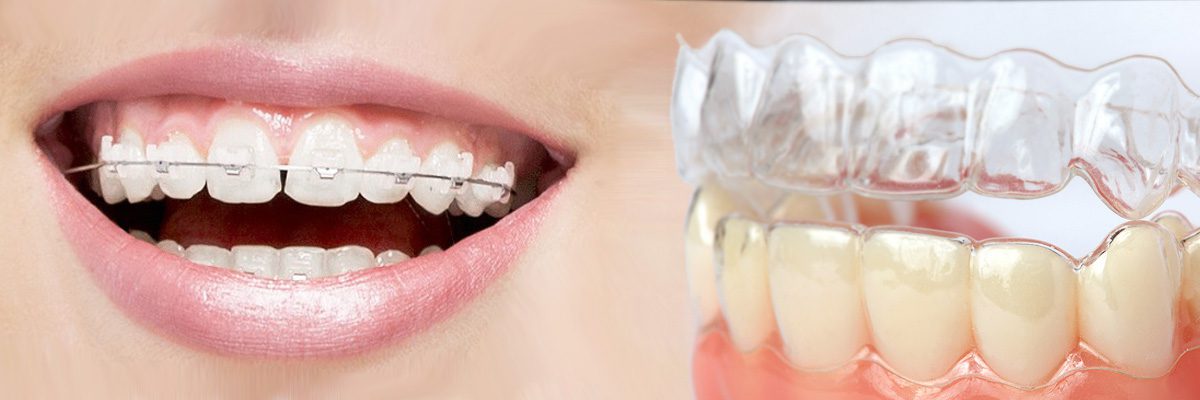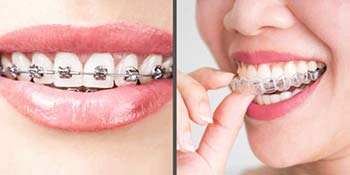Braces Vs Invisalign: What are the differences?
March 20, 2023
Braces Vs Invisalign: What are the differences?
More than 90% of people agree that a nice smile greatly affects a person’s overall looks. Many individuals, therefore, choose braces or Invisalign to get the desirable result of a beautiful smile with well-aligned and healthy teeth. Straightening or aligning teeth is a common dental procedure, and a few options are available.
Both choices have advantages and disadvantages, thus, making a final orthodontic treatment decision is up to the individual. In this piece, we’ll contrast the two solutions so you can make an informed choice about treatment options and whether to opt for the Invisalign treatments or traditional braces. Let’s find out more in detail about them.

What Are Braces?
Orthodontists recommend braces braces as an effective treatment used to straighten teeth from bieng crooked teeth or crowded. Metal brackets are attached to each tooth using adhesive and then linked together using a wire to restrict the tooth movements.
What Is Invisalign?
Invisalign are clear aligners, that have a virtually invisible appearance. The invisible aligners are made from plastic nowadays. Unlike Braces, they have no elastic, metal wires, or brackets that are visible to the naked eye.
Typically, Invisalign clear aligners should be updated every two weeks to enhance the treatment time for your desired position of teeth alignment. They can be removed in the comfort of one’s own home using a simple process.
Invisalign is worn until the teeth have moved to their final positions. Depending on many factors, & on the individual, progression to correct position might vary from a few months to as long as two years.
The Difference Between Braces and Invisalign aligners
To evaluate the differences between the two, we’ve set out five standards to judge both of orthodontic therapy options to give you a better idea.
Appearance
When it comes to outward looks, Invisalign triumphs over braces. Unlike traditional braces, which can be easily seen, Invisalign treatment is discreet appearance which is almost invisible because the Invisalign aligner trays are clear.
While some youngsters can take pleasure in their orthodontist visits customizing their braces with brightly colored rubber bands. Most kids and adults tend to choose the more discreet option of Invisalign aligners. For those who value secrecy, Invisalign is the clear winner for straightening teeth.

Convenience
When it comes to ease of use, both braces and Invisalign have their advantages and disadvantages. While the lack of removal time for metal braces is an advantage, the inability to consume certain foods can be an annoyance.
Even though Invisalign makes it easy to enjoy your favorite hard and sticky foods, many people forget to remove the clear aligners after each meal and store them safely.
Invisalign might not be ideal if you or your kid have a habit of losing items. Excusing oneself from a group meal to take out the trays and replace them afterward might also be a hassle.
Treatment Pricing
Traditional braces are often less expensive. However, brackets and wires can add up quickly in braces cost, so plan on spending between $2,500 and $8,000 for braces treatment. The number of trays needed affects the total price of Invisalign treatment.
The number of trays you’ll need to make the necessary adjustments to your teeth can vary. The Invisalign costs range from $3,000 to $8,000. Before making a final selection, discuss costs with your orthodontist.
To varying degrees, Invisalign treatment can be covered by dental health plans. If you want to know how much getting braces or Invisalign will cost, your best bet is to get in touch with your Orthodontist Clinic.
Effectiveness and Efficiency
For quite some time, people have turned to braces to correct misaligned teeth and improve their smiles’ appearance. Patients must wear their braces as directed by their orthodontist, which means they must always remain on the teeth.
The fact that trays can be taken out means that patients can not always wear them for the recommended amount of time. Further, your teeth will move when you are not using the trays if you lose them or fail to use them.
Wearing trays for less time than advised might increase the duration of treatment. When teeth are badly out of place, traditional braces also perform better. Rotated or overlapped teeth might be difficult for Invisalign to correct.

Comfortability
The process of having your teeth straightened can not be the most pleasant one. Changing the position of your teeth can be uncomfortable, regardless of whether you use braces or Invisalign.
Lingual braces are inconspicuous orthodontic braces bonded to the back of a patient’s teeth to give them more comfort. Patients can now also use ceramic braces to ensure less noticeability of braces. Invisalign, on the other hand, is preferable to traditional metal braces since it puts less strain on the teeth.
The inner lip and the tongue are particularly vulnerable to being wounded by the braces’ sharp edges. Brackets made of metal provide a hazard if you or your kid participates in sports in which accidental contact is possible. Brackets or aligners, whether metal or clear, can become tolerable after some adjustment.
Wait! Which One is Easier to Clean?
Whether you’re straightening your teeth with braces or Invisalign, you still need to give special attention to oral health. Brushing and flossing can be regularly go while wearing braces, simplifying the cleaning procedure. Nevertheless, a smaller brush could be necessary if food is trapped in the metal.
Flossing and brushing are still effective with Invisalign, but you’ll need to take extra steps to maintain the trays. The trays should be wiped down after every meal. Invisalign patients should wash and brush their teeth with hot water or use an Invisalign-specific cleaning solution.
Invisalign trays can be difficult to clean, particularly when you’re not home. Furthermore, a buildup of germs or solid food might occur if the area is not cleaned regularly. Brushing and flossing regularly is essential regardless of whether you wear braces or Invisalign, but it is more crucial if you do.

The Bottom Line: Make the Right Decision for Your Dental Hygiene
Your orthodontic treatment might benefit from either traditional braces or more discreet Invisalign aligners. Your orthodontist could recommend which treatment option would be most appropriate, given your treatment objectives and lifestyle preferences. Make an appointment for a free consultation with Glow Orthodontics to find out which option best suits your needs.